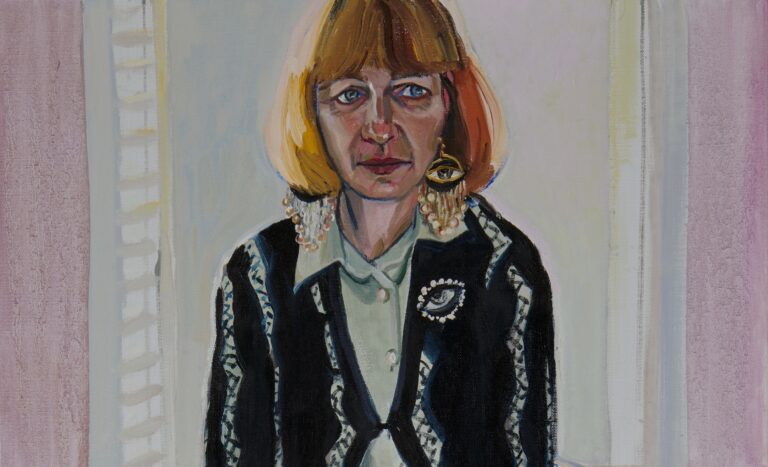In early September I was on my way to meet Lotte Crawford in the east end of London, listening to Julian Barnes’ Keeping an Eye Open as I drove. It was the chapter about Pierre Bonnard, the painter whose blazing colours had such an influence on me as a young student, enchanting the way I look at the world. I was so engrossed in Barnes’ writing that I forgot to look where I was going, and twice other motorists hooted in frustration at my indecisive driving.
Lotte is an art historian of modern pattern and textiles. The subjects of her upcoming books are the English designer Enid Marx and the painter and engraver Tirzah Garwood. Her affinity for the handmade was evident inside her quaint Victorian terraced house, which overflowed with paintings, ceramics and other artefacts.
For the sitting, Lotte chose a steel grey sofa in her living room, set against a dark green wall. She wasn’t alone though: the sofa was also claimed as a scratching post by her beautiful grey cat, Astrid. I was struck by this creature’s combination of teddy bear-like softness and piercing yellow ochre eyes. He would not pose today, so I took a photograph and later squeezed him into the composition next to Lotte’s shoulder.
Lotte settled into a lotus pose, which amazingly she maintained long enough for me to finish two drawings with colouring pencils. She was a quiet sitter, except when talking enthusiastically about her love of textiles, alluded to in the painting by the elegant silk wrap draped around her shoulders. But it was her youthful, shy presence I really wanted to capture in my drawings.
Fast-forward to late October, and the situation in my studio was becoming intense. I had ten portraits on the go, a new way of working for me but one I will try to maintain in future projects. Working on numerous portraits at the same time helps to smooth over the slump that usually occurs between the completion of one painting and the beginning of the next one. Finishing a painting can be like finishing a great book: you’re not ready to move on for a while. This is when procrastination can set in, and procrastination can quickly curdle into self-doubt and despair.
At this point Lotte’s portrait had received its acrylic wash and was ready for more detailed oil painting. I longed to paint expressively with big brushes, to scrape and scrub the canvas in search of interesting textures, but I found myself painting carefully within the outlines. Such frustration is a price you have to pay if you like strong outlines around your figures, which I certainly do. Maybe this stems from my love of drawing and printmaking, or the painters I have taken inspiration from: Max Beckman, Suzanne Valadon, van Gogh, Alice Neel, Munch, Mela Muter, Kokoshka. These artists taught me that outline gives a certain solidity to a figure, emphasising presence and personality, while imparting a sense of confidence to the painting as a whole. Above all, it is a good way to avoid blurriness and indecision: everything must be well defined.
But making this style work is also a question of mood. I want my attention absorbed in concentration on the portrait, creating a sense of relaxed focus similar to meditation. Music can help with this. I tend to listen to the same playlists repeatedly, often featuring the Four Seasons recomposed by Max Richter, as well as Wim Mertens. Immersing myself in these soundscapes is as much part of my routine as cleaning my palette and washing my brushes. It creates a sense of security and calm, an important dimension of my studio environment.
Nine months later, after a third pass at Lotte’s portrait, I decided I was satisfied. The painting seemed to communicate her calm, youthful demeanour, and I didn’t want to lose this freshness through any further changes I might be tempted to make. So I chose not to do a second sitting from life.
But subsequent events made me question whether I had really captured Lotte. She mentioned on social media that she had published an essay about Gillian Rose’s 1995 memoir, Love’s Work. Reading Lotte’s piece, I was touched by her sorrowful account of a difficult time in her own life, exploring her desires for belonging and self-affirmation. It made me glimpse a new emotional dimension in her character, and I wondered if my portrait did justice to it.
This made me reflect that there is always something provisional in an artist’s attempt to represent an individual, since there is always more to learn.

